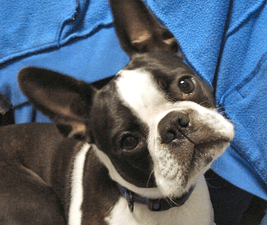Dogs are complex creatures with sophisticated thinking ability. But dogs don’t think like people. They can solve problems/puzzles. They can understand hundreds of words, if taught to do so. MRI brain studies also prove they experience many of the same emotions as people, including love, joy, happiness, and grief. It’s only natural that most people assume their dogs understand cause and effect. Those people are wrong.
If dogs could put the two things together, they’d never do most of the stuff that gets them in trouble. For example; Simon (Fran’s 4-year-old Boston Terrier) likes to eat grass. Every time he eats grass, he pukes. Every single time. He doesn’t like that part. Not at all. It’s obvious to any human that eating grass makes Simon throw up. It’s never crossed Simon’s mind that maybe, just maybe, eating grass isn’t a good thing to do.
The link between “cause” and “effect” is missing in dogs’ brains.
There’s only now
At least part of the reason is because dogs don’t seem to have the same kind of memory that people do. If the grass consumption was further ago than “now,” it’s slipped from his awareness.
A more classic example is the case of dogs and house-breaking. If a dog had an accident in the house while the people were away, very old conventional training had you rubbing the dog’s face in it and screaming “No!” even if it happened hours before. Fortunately, that nonsense has gone by the wayside. The only thing it accomplished wasn’t the goal. It taught dogs that people “finding” a mess was bad. So they learned to hide it, instead of learning not to do it.
Instant gratification
It’s crucial, when teaching your dog anything, to react instantly. Don’t let any time elapse between action and praise/reward. If your dog drops the wad of grass when you say “Leave it!” his reward has to come right away. If you’re late with the reward, he’s already grabbed another tuft and is merrily chewing away. So you find yourself rewarding chewing grass, instead of rewarding the drop. And because he’s so darn fast grabbing it, that’s why Simon’s on leash, even in his own yard.
Cause and effect is missing in dogs’s thought processes. And, adaptable and trainable as they are, so is generalization. People generalize all day, every day. Once you know how to use a spoon, you know how every spoon works. Everywhere. No matter the size, shape, color, texture, or material. All spoons work the same, and every person can use every spoon everywhere. But a dog’s “spoon” in the kitchen is different from the “spoon” in the dining room. They can be taught to generalize, but it’s not part of the original package.
And that’s why your dog doesn’t know “Sit!” when you’re at the vet’s office, or the groomer, or at Grandma’s house. Just a couple of minutes “training” your dog to sit wherever you are will do the trick. It’s kind of funny to watch, because you can almost see the light bulb turn on in their brains when they get it. “Oh, you mean this sit? Really? That’s all I have to do?”
Try it at home
It’s easy, and fun, to try with your own dog. If there’s something you always do with your dog try changing it just a little. Friends of ours had a routine where each of their five dogs went with “dad” to the pantry every night to get an M & M candy before bed. They would all sit politely in the same order and wait for their piece of candy. (Despite what you’ve heard about chocolate being poisonous to dogs, one M & M won’t matter to most dogs.) It would have blown their little minds if Dad had moved the routine over by the fridge.
We’re not advocating confusing your dogs on a regular basis. What we are saying is that trying familiar things in new surroundings will expand your dog’s thinking and let both of you have a little bit of fun. Change up your routine and let us know how your dog reacts. It can be eye-opening for both of you!
Enjoyed this post? Click here to sign up for the weekly newsletter and never miss another!















